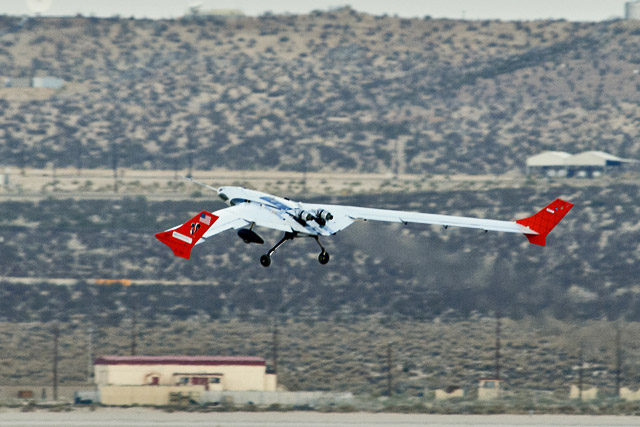The US Air Force Research Laboratory and Lockheed Martin have kicked off an $18 million research programme into active aeroelastic control technologies, which if proved practical would in principle translate into thinner, lighter and better optimised wings with a much higher aspect ratio than is possible with the rigid wings that have characterised most powered flight to-date.
The initial USAF programme, which is worth about $18 million, covers the cost of developing the unmanned X-56 and performing about 20 initial test flights on the purpose-built machine. It includes two of the Lockheed Martin-built aircraft, three sets of fibreglass high-aspect ratio aeroelastic wings and one "stiff" wing.
Initial flights, including a 26 July data-gathering sortie, are being undertaken with the stiff wing. Later flights will use the lighter, more flexible fiberglass wings. These are detachable because of the high-risk nature of the testing, and the aircraft also has a built-in parachute to hopefully prevent the total loss of an airframe if there is an accident.
 |
|---|
| USAF |
NASA will take possession of the two X-56As and four sets of detachable wings later this year to continue the research. It is also developing its own wings for the aircraft and will fly its own stiff wing "next spring", says Gary Martin, NASA's fixed-wing project manager at the Dryden Flight Test Center at Edwards AFB, California. Later, NASA will add its own advanced sensors, which it is developing along with a different wing, to be flown towards the end of the five-year test programme.
The objective is to embed sensors in the X-56's wings to detect flutter and gust loads and counter the resulting bending and twisting with the aircraft's control surfaces. Eventually, real-time control of those flexing movements might be possible.
"This programme actually came out of studies and technology development that were geared towards a future intelligence, surveillance and reconnaissance capability," says Pete Flick, AFRL programme manager. Martin adds that the technology could also be applied to future commercial aircraft that might enter service after 2035.
Ironically, controlling the flex of the wing would revive a control technique used by the Wright brothers. Their 1901 and 1902 gliders and successful 1903 "Flyer" mimicked birds by "wing warping", although modern aircraft have long since opted for rigid wings and control by moveable spoilers or ailerons.
Source: Flight International
















